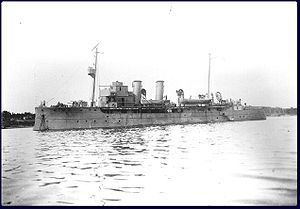Name Margaret Commissioned 1915, as HMCS Margaret In service 1914 Launched 1914 Displacement 685,800 kg | Acquired 1914 Decommissioned 1919 Out of service 1932 Length 56 m Draft 4.6 m | |
 | ||
Builder John I. Thornycroft & Company | ||
CGS Margaret was a Canadian Government Ship, and was the first vessel to be built specifically for the Customs Preventive Service. Delivered in 1914, she was transferred to the Royal Canadian Navy and served as HMCS Margaret during the First World War. Following the war, Margaret was returned to the Customs Preventive Service, and was transferred to the Royal Canadian Mounted Police in 1932. Sold shortly thereafter, she was subsequently acquired by the Brazilian Navy and renamed Rio Branco.
Contents
Origins and military service
Originally intended as a customs cruiser, CGS Margaret was built at Thornycroft's Woolston Works and delivered to the Department of Customs at Halifax in April 1914. With her two six-pounders, she was suitable for a patrol vessel, and given her similarities to a 1907 coastal defence cruiser that was never built, Margaret may in fact have been ordered in anticipation of war with Germany. CGS Margaret became HMCS Margaret when she was transferred, together with CGS Canada, to the Royal Canadian Navy on 4 August 1914 following the outbreak of the First World War. Commissioned in 1915, Margaret was used as an escort and patrol vessel in Atlantic coastal waters during the war, and was one of the first vessels in which Rear Admiral Leonard W. Murray served at the start of his distinguished military career. Margaret was at Dockyard Jetty 2 in Halifax Harbour during the Halifax Explosion. She broke her moorings and suffered minor damage, while two of her crew were killed ashore.
During the war, Morse's Tea and Coffee Company produced a series of 50 cards of ships; no.35 was HMCS Margaret.
Customs service
Following the end of the war, HMCS Margaret was returned to the Customs Preventive Service (CPS), and carried out her first patrols in the Gulf of St. Lawrence and on the East Coast in the spring of 1919. Converted from coal to oil burning in 1925, her armament was also reduced in 1927 to one six-pounder and seventeen rifles. During these years, much of her work consisted of customs patrols against rum running. In 1932, the CPS was absorbed by the Royal Canadian Mounted Police (RCMP), and the service's personnel and ships were transferred to the RCMP's Marine Section.
Brazilian service
Following the transfer of the CPS's responsibilities to the RCMP in 1932, the number of personnel was reduced and some former CPS vessels were discarded. Margaret was among the CPS vessels sold later that year as a result of these cutbacks, and was acquired by the Brazilian state of São Paulo, which named her Ruth, during the Constitutionalist Revolution of 1932. Confiscated by the Brazilian government, she was renamed Rio Branco and was converted to a hydrographic survey ship for the Brazilian Navy in 1934. After serving as a coastal escort vessel in the Second World War, Rio Branco returned to hydrographic work and was discarded in 1957 or 1958.
